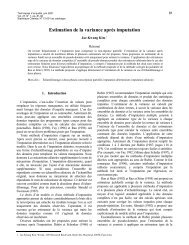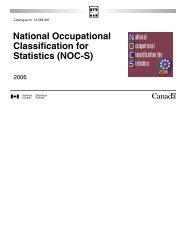Gender Differences in Police-reported Violent Crime in Canada, 2008
Gender Differences in Police-reported Violent Crime in Canada, 2008
Gender Differences in Police-reported Violent Crime in Canada, 2008
You also want an ePaper? Increase the reach of your titles
YUMPU automatically turns print PDFs into web optimized ePapers that Google loves.
<strong>Gender</strong> <strong>Differences</strong> <strong>in</strong> <strong>Police</strong>-<strong>reported</strong> <strong>Violent</strong> <strong>Crime</strong> <strong>in</strong> <strong>Canada</strong>, <strong>2008</strong><br />
by Roxan Vaillancourt<br />
Introduction<br />
<strong>Police</strong>-<strong>reported</strong> data show that the risk of violent victimization among adult males (aged 18 years of age and over)<br />
is comparable to that of adult females. Adult females accounted for 51% or about 152,000 of the 298,000 victims of<br />
violent <strong>in</strong>cidents 1 <strong>reported</strong> to the police <strong>in</strong> <strong>2008</strong>, while some 146,000 victims were male (Table 1, Table 2).<br />
There are many consequences associated with be<strong>in</strong>g a victim of a violent crime <strong>in</strong>clud<strong>in</strong>g <strong>in</strong>juries, <strong>in</strong>creased<br />
stress levels and disruption to day-to-day activities. Accord<strong>in</strong>g to the 2004 General Social Survey (GSS) on<br />
Victimization, 24% of victims who susta<strong>in</strong>ed <strong>in</strong>juries due to a violent victimization sought medical attention and 20%<br />
required bed rest. In addition, 81% of victims experienced some form of emotional reaction such as anger,<br />
confusion or be<strong>in</strong>g fearful, and one-third <strong>reported</strong> hav<strong>in</strong>g problems sleep<strong>in</strong>g (AuCo<strong>in</strong> and Beauchamp, 2007).<br />
Be<strong>in</strong>g a victim of a violent crime may lead <strong>in</strong>dividuals to question their perceptions of crime levels <strong>in</strong> their<br />
neighbourhood and their overall safety. For more than half (52%) of victims of violent crime, the experience had an<br />
impact on their day-to-day activities (AuCo<strong>in</strong> and Beauchamp, 2007).<br />
Despite comparable overall rates of police-<strong>reported</strong> violent victimization, the data show that women and men<br />
experience differences <strong>in</strong> the types of violence experienced, the type of weapon used aga<strong>in</strong>st them and the level of<br />
<strong>in</strong>jury susta<strong>in</strong>ed.<br />
This profile exam<strong>in</strong>es the nature and extent of gender differences <strong>in</strong> police-<strong>reported</strong> violent victimization between<br />
male and female adults aged 18 years and over. It analyses gender differences <strong>in</strong> victimization based on the<br />
prevalence across the prov<strong>in</strong>ces and territories, the type of violent offence, the location of the <strong>in</strong>cident, the presence<br />
and type of weapon used, the level of <strong>in</strong>jury to the victim, the victim’s relationship to the perpetrator, and the age of<br />
the victim.<br />
The analysis primarily uses police-<strong>reported</strong> data collected through the Incident-based Uniform <strong>Crime</strong> Report<strong>in</strong>g<br />
(UCR2) Survey, as well as some data from the Homicide Survey. It is important to note, however, that police-<strong>reported</strong><br />
data reflect only those <strong>in</strong>cidents that have come to the attention of the police. The 2004 GSS on Victimization, for<br />
<strong>in</strong>stance, estimated that 61% of adult males and 74% of adult females who had been violently victimized did not<br />
report the <strong>in</strong>cident to the police.<br />
Accord<strong>in</strong>g to the 2004 GSS, victims of violent crime may not report their victimization to the police for various reasons.<br />
For example, the victim may choose to deal with the <strong>in</strong>cident <strong>in</strong> another way, feel that the <strong>in</strong>cident was not important<br />
enough to warrant contact<strong>in</strong>g the police or not want the police to be <strong>in</strong>volved.<br />
Overall rates of violent victimization are comparable between males and females<br />
<strong>Police</strong>-<strong>reported</strong> data show that <strong>in</strong> <strong>2008</strong>, the rate of violent victimization for female and male victims was<br />
comparable, at 1,155 and 1,150 per 100,000 population, respectively (Table 1, Table 2). Moreover, throughout<br />
1. A victim can be accounted for <strong>in</strong> more than one <strong>in</strong>cident of victimization <strong>in</strong> the same year. Accord<strong>in</strong>g to the 2004 General Social Survey (GSS), victims who<br />
have suffered more than one <strong>in</strong>cident of victimization (33% of victims) accounted for 60% of the total number of victimization. The police-<strong>reported</strong> data<br />
used <strong>in</strong> this report cannot determ<strong>in</strong>e whether the same victim is subject to multiple victimizations. In addition, police-<strong>reported</strong> data refers to the number of<br />
victimizations and not the number of victims.<br />
6 Statistics <strong>Canada</strong> – Catalogue no. 85F0033M, no. 24
















